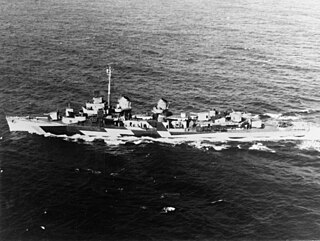
USS Franks (DD-554), a World War II-era Fletcher-class destroyer in the service of the United States Navy, was named after Medal of Honor recipient Acting Master's Mate William Joseph Franks.

USS O'Flaherty (DE-340) was a John C. Butler-class destroyer escort built for the United States Navy during World War II. She was named for Ensign Frank Woodrow O'Flaherty, a pilot who posthumously received the Navy Cross for his actions at the Battle of Midway.

USS Stafford (DE-411) was a John C. Butler-class destroyer escort in the United States Navy. She was named after Richard Y. Stafford (1916–1942), a United States Marine Corps Captain who died during the Battle of Guadalcanal.

USS Halligan (DD-584) was a Fletcher-class destroyer of the United States Navy, named for Rear Admiral John Halligan, Jr. (1876–1934).

USS Hale (DD-642), a Fletcher-class destroyer, was the second ship of the United States Navy to be named for Maine Senator Eugene Hale (1836–1918).

USS Twiggs (DD-591), a Fletcher-class destroyer, was the second ship of the United States Navy to be named for Marine Major Levi Twiggs (1793–1847).

USS Schroeder (DD-501), a Fletcher-class destroyer, was a ship of the United States Navy, named for Rear Admiral Seaton Schroeder (1849–1922). Entering service in 1943, the ship saw action during World War II, participating in the Battle of Tarawa. Following the war the destroyer was placed in reserve, remaining in this state until 1972. She was sold for scrap in 1974.

USS Capps (DD-550), a Fletcher-class destroyer, was a ship of the United States Navy named for Rear Admiral Washington L. Capps (1864–1935).

The third USS Macdonough (DD-351) was a Farragut-class destroyer in the United States Navy during World War II. She was named for Thomas Macdonough.

USS Haggard (DD-555) was a Fletcher-class destroyer of the United States Navy named for Captain Haggard of the Louisa, who fought in the Quasi-War.

USS Longshaw (DD-559), a Fletcher-class destroyer, was a ship of the United States Navy named for Dr. William Longshaw, Jr. (1839–1865), who served in the Navy and was killed during the Civil War.

USS Harrison (DD-573) was a Fletcher-class destroyer of the United States Navy. She was second Navy ship of that name.

USS Swearer (DE-186) was a Cannon-class destroyer escort in the United States Navy during World War II. She was later transferred to the French Navy as Bambara.

The second USS Fleming (DE-32), and first ship of the name to enter service, was an Evarts-class destroyer escort built for the United States Navy during World War II. While performing convoy and escort duty in the Pacific Ocean she was also able to sink one Japanese submarine and to shoot down several kamikaze planes that intended to crash onto her. For her military prowess under battle conditions, she was awarded four battle stars.

USS Sederstrom (DE-31) was a Evarts-class destroyer escort of the United States Navy during World War II. She was promptly sent to the Pacific Ocean to escort convoys and to protect other ships from Japanese planes and submarines. Her assignments took her from one battle area to another, but she was fortunate in remaining almost unscathed by the end of the war. For her efforts in battle areas, she was awarded five battle stars by war's end.

The second USS Tisdale (DE-33) was an Evarts-class destroyer escort of the United States Navy during World War II. She was promptly sent off into the Pacific Ocean to protect convoys and other ships from Japanese submarines and fighter aircraft. She performed dangerous work in numerous battle areas, and was awarded four battle stars.

USS Wesson (DE-184) was a Cannon-class destroyer escort built for the United States Navy during World War II. She served in the Pacific Ocean and provided escort service against submarine and air attack for Navy vessels and convoys. She returned home at war's end with a very respectable seven battle stars to her credit.

USS Richard S. Bull (DE-402) was a John C. Butler-class destroyer escort in service with the United States Navy from 1944 to 1946. She was finally sunk as a target in 1969.

USS Conklin (DE-439) was a John C. Butler-class destroyer escort in service with the United States Navy from 1944 to 1946. She was scrapped in 1972. Conklin (DE-439) was named in honor of George Emerson Conklin who was posthumously awarded the Navy Cross for his brave actions on Guadalcanal.

USS Howard F. Clark (DE-533) was a John C. Butler-class destroyer escort in service with the United States Navy from 1944 to 1946. She was sold for scrapping in 1973.




















